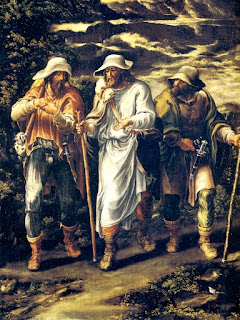The risen Christ, who bore the wounds
of the Crucified, was no longer bound by space and time.
YOUCAT Catechism +
Catechism of the Catholic Church Lesson 107
Ave Maria series
107 Through his Resurrection, did Jesus return to
the physical, corporeal state that he had during his earthly life?
The risen Lord allowed his disciples to touch him; he ate
with them and showed them the wounds of his Passion. Nevertheless, he body belonged no longer only
to this earth, but rather to the heavenly kingdom of his Father. [645-646]
The unrecognized Jesus with two
disciples along the road to Emaus after his resurrection. Afterwards they said to each other, “Were not our hearts
burning [within us] while he spoke to us on the way and opened the scriptures
to us?” (Luke 24:32) ....107
The risen Christ, who bore the wounds of the Crucified was
no longer bound by space and time. He
could enter through locked doors and appear to his disciples in various places
in a form in which they did not recognize him immediately. Christ’s Resurrection was, therefore, not a
return to a normal earthly life, but rather his entrance into a new way of
being: “For we know that Christ being raised from the dead will never die
again; death no longer has dominion over him” (Romans 6:9).
(Jesus appears to Mary Magdaline, who does not recognize him
immediately.) Jesus said to her, “Mary,”
She turned and said to him in Hebrew, “Rabboni!” (which means Teacher). John 20:16
[645-646]
The condition of Christ's risen
humanity
645 By means of touch and the sharing of a meal, the risen
Jesus establishes direct contact with his disciples. He invites them in this
way to recognize that he is not a ghost and above all to verify that the risen
body in which he appears to them is the same body that had been tortured and
crucified, for it still bears the traces of his Passion (compare Luke 24:30,39-40,41-43; John 20:20,27; Jn 21:9,13-15).509 Yet at the same time this authentic, real
body possesses the new properties of a glorious body: not limited by space and
time but able to be present how and when he wills; for Christ's humanity can no
longer be confined to earth, and belongs henceforth only to the Father's divine
realm (compare Mathew 28:9, 16-17; Luke 24:15,36; John 20:14,17,19,26; Jn 21:4).510 For this reason too
the risen Jesus enjoys the sovereign freedom of appearing as he wishes: in the
guise of a gardener or in other forms familiar to his disciples, precisely to
awaken their faith (compare Mark 16:12; John 20:14-16; Jn 21:4,7).511 —Catechism
of the Catholic Faith, Second Edition
646 Christ's Resurrection was not a return to earthly life,
as was the case with the raisings from the dead that he had performed before
Easter: Jairus' daughter, the young man of Naim, Lazarus. These actions were
miraculous events, but the persons miraculously raised returned by Jesus' power
to ordinary earthly life. At some particular moment they would die again.
Christ's Resurrection is essentially different. In his risen body he passes
from the state of death to another life beyond time and space. At Jesus'
Resurrection his body is filled with the power of the Holy Spirit: he shares
the divine life in his glorious state, so that St. Paul can say that Christ is
"the man of heaven (compare 1 Corinthians 15:35-50)".512 –CCC
JR Jesus

No comments:
Post a Comment